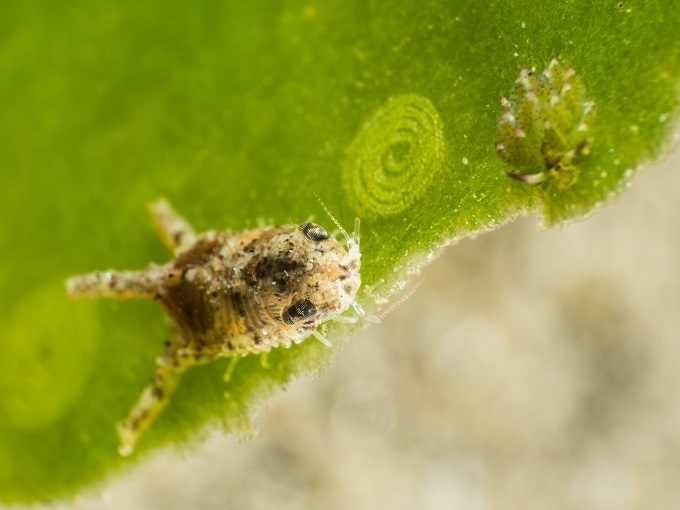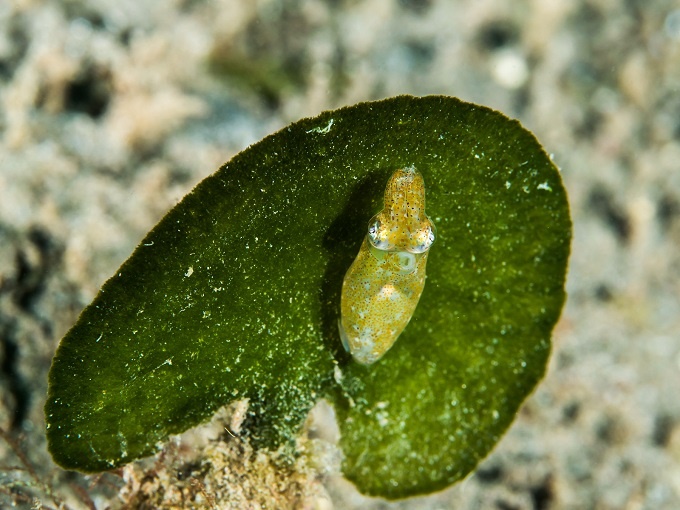When diving, there are often many, many things to look at: too many fish, too many corals, feather stars or sponges. Sometimes, there is so much to see that it is difficult to find out where to put your focus. It can honestly be quite overwhelming. But on sandy sea beds, many divers can hardly find anything to look at. Everything looks grey, black or dull. However that is far from the truth.
In this little article we are going to show you one object that can easily be recognized and that stands out from the rest of the seemingly grey area. As soon as you spot it, you can always find interesting animals living on and in it, even though at first glance, it looks like nothing but a green leaf. You are about to get a peek into the life on an Avrainvillea leaf. Don’t worry, you do not have to remember the name! We are pretty sure you will remember what it looks like, and this knowledge can give you an exciting experience the next time you see one.
 Ann Karin Matberg • Tough TG-5 • PT-058
Ann Karin Matberg • Tough TG-5 • PT-058
In front of us the sandy sea bed reaches as far as the eye can see. The brown carpet is only broken by numerous small, seemingly insignificant green leaf-like structures standing up from the bottom. “What a boring dive site” you might think, as this is the only thing that catches your eye. But trust me, every time you see one of these green algae, you should slow down and start searching. If you brought a magnifying glass with you, it might be of significant help, since many of the animals living here are both extremely well camouflaged and small. Another good advice is to take a picture, either in microscope mode or with your macro lens, and then zoom in on the picture. What first looked like a piece of dust might be very much alive.
The first time my guide pointed at the green leaf, I thought “What...? There is nothing but a piece of dirt on this.” Then suddenly, I realized the piece of dirt was moving around! No current could be the cause of this movement, so I got closer, and was suddenly eye to eye with what must be one of the most charming animals in the underwater world. The Shaun the Sheep sea slug. I immediately fell in love, and this love has lasted for more than a decade now. It is simply adorable! Since then, I have learned that Shaun the Sheep is correctly named Costasiella kuroshimae, and that it has several cousins that can all be found on the same type of green leaf. If you have ever seen the animation figure Shaun the Sheep, you will understand why the sea slug has gotten this name.

Ann Karin Matberg • OM-D E-M1 Mark II • M.Zuiko Digital ED 60 mm F2.8 Macro
• PT-EP14 • PPO-EP02 • 2 x UFL-3
Shaun and its cousins might look like nudibranchs, but they are actually not closely related to them. This sea slug feeds on the chloroplast (the green stuff) on the surface of the algae, and incorporates it into its own body. As soon as the chloroplast is in the body of the animal, the slug gets energy from the photosynthesis occurring inside the chloroplast. It is like eating an irradiator. Quite convenient I would say!
Here you can clearly see the small, green balls of chloroplast that the slug is eating

Ann Karin Matberg • OM-D E-M1 Mark II • M.Zuiko Digital ED 60 mm F2.8 Macro
• PT-EP14 • PPO-EP02 • 2 x UFL-3
When you learn what the algae look like, they are very easy to recognize. And when you see the algae, you can start looking for your own well-hidden jewels. There are so many different animals seeking shelter there. Even though I always look for Shaun the Sheep first, I never know what to expect when I approach a green leaf. One of the weirdest things I have seen so far was a large-eyed animal that looked like a crossing between an airplane and an alien. The dive guide had no clue what it was, but we found out later that it was an isopod. In terms of looks, we would probably find it at the total opposite on the charm-scale compared to Shaun, and I think we all can be pretty happy that it only grows to a couple of centimeters. Imagine meeting a two-meter isopod!
 Ann Karin Matberg • OM-D E-M1 Mark II • M.Zuiko Digital ED 8 mm F1.8 Fisheye PRO
Ann Karin Matberg • OM-D E-M1 Mark II • M.Zuiko Digital ED 8 mm F1.8 Fisheye PRO
• PT-EP14 • PPO-EP02 • 2 x UFL-3
Other charming little things you often find here are the baby squid and the baby cuttlefish. They are super cute! Often hiding at the stem or on the backside of the algae they are so well camouflaged that they are easy to miss. Not so charming is the skeleton shrimp. This is even closer to an alien than the isopod we have just talked about. Despite the name, it is not really a shrimp, but an amphipod. You can find it in oceans all over the world, and with its long, slender body, antennas and massive claws it can look quite scary when you see it up close. Thank god that it is only a couple of centimeters long! Next time you see these creatures, stay there for a while, and you will probably see them fight! Since they often stay together in larger groups, the interactions between them can get pretty harsh. If you see a skeleton shrimp that looks fluffy, it is probably a female that has just given birth. The babies cling to their mother’s body until they are old enough to take care of themselves.
 Ann Karin Matberg • OM-D E-M1 Mark II • M.Zuiko Digital ED 8 mm F1.8 Fisheye PRO
Ann Karin Matberg • OM-D E-M1 Mark II • M.Zuiko Digital ED 8 mm F1.8 Fisheye PRO
• PT-EP14 • PPO-EP02 • 2 x UFL-3
Fish and shrimps of different kinds also frequently stay in or around the green leaves. Several species can easily stay on the same algae without bothering each other. Charming gobies are also quite common, and the green background can really make your fish pop in a picture.
Hopefully this article has given you some insight into what you can find living on this not so insignificant green alga. So next time you see one, slow down and really explore what is living here.

Ann Karin Matberg • OM-D E-M1 Mark II • M.Zuiko Digital ED 8 mm F1.8 Fisheye PRO
• PT-EP14 • PPO-EP02 • 2 x UFL-3
Comments
Show more comments (9)